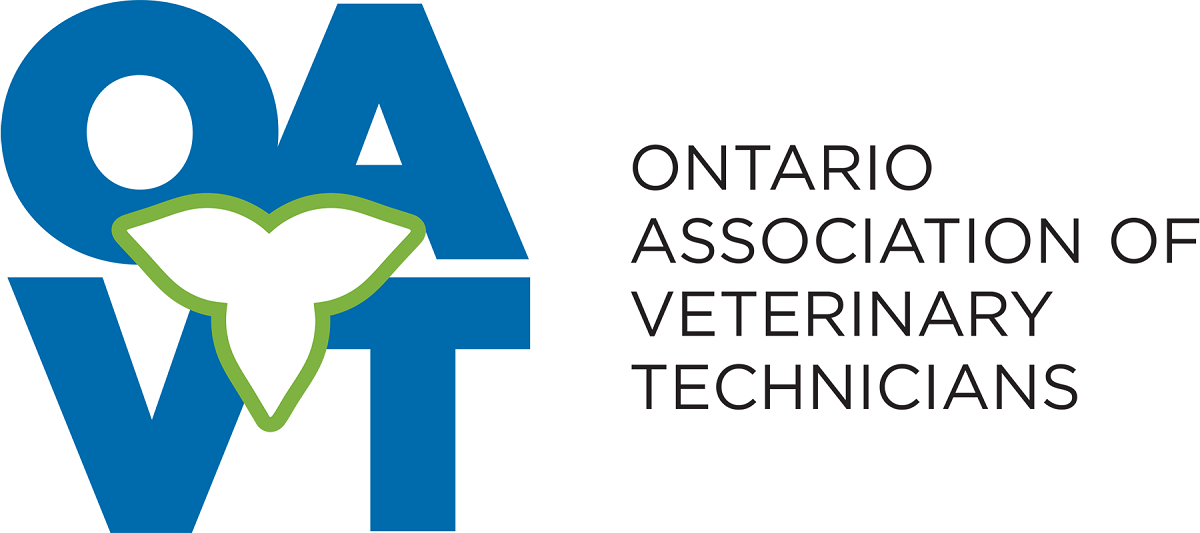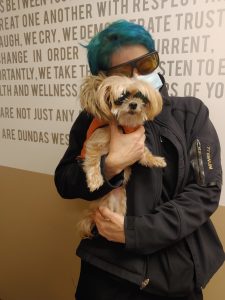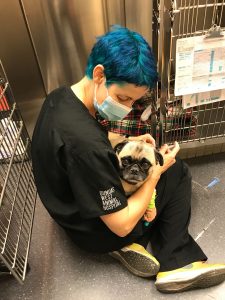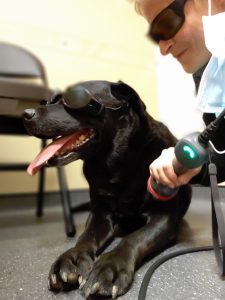Soňa Holičová, BSc., RVT
What is your current job(s)?
I work as an RVT at a hospital that is as unique as everyone in it. I also do part-time bookkeeping and I do the occasional house call for a pet who can’t come to the hospital for whatever reason.
Where did you go to school?
I never finished “traditional” high school because I was 15 years old when my family immigrated to Canada, from former Czechoslovakia. I did not speak a word of English, and school did not interest me at all, until another 15 years later when I set my intentions to apply to the DVM program at University of Guelph. I had no existing prerequisites, so I spent the first three years at York Memorial Adult Learning Centre earning my high school equivalency, starting at grade 10. While in “high school”, I started my first job at a small animal practice downtown Toronto, working as an on the job trained vet assistant. I had no experience working in a clinic, but my vet was patient and kind, and he taught me his ways. It was here that my inspiration and drive to become a vet grew exponentially, and I applied and was accepted to the BSc. program at University of Guelph, with a Major in Animal Biology, and Minor in Classical Languages (Latin and Ancient and Greek). I was hoping to transfer to the DVM program after two years, but I was denied further government assistance, and was unable to afford the DVM tuition. I was already working 5 part-time jobs while in university, just to be able to finish my undergraduate degree.
What led you to the role of RVT? What made you want to pursue your certification? What made you decide to take a Veterinary Technology program?
I was trained on the job for many years. I had worked alongside many vets. I developed valuable practical skills and general knowledge in veterinary medicine over the years, but I didn’t feel I knew enough theory, which limited my ability to efficiently communicate with and educate pet owners. When my veterinarian whom I’ve known for 13 years, and worked with for 8 of those years, announced that he would be retiring, I decided to go to back to school and get my RVT licence, so that I would never have to start from scratch again, working for less than minimum wage.
Where did you get your RVT diploma?
I studied Veterinary Technology at Sheridan College, Davis Campus in Brampton. I graduated with honours and received an OVMA Veterinary Technician Award for above average standing with an emphasis on clinical practice.
What other jobs have you had in the RVT field?
Since graduating from Sheridan, I spent 6 months in an ICU/Wards department of an emergency referral hospital, I have accompanied vets during house call visits, assisting with all routine medical and technical procedures, often involving end of life care, support, and guidance. When the pandemic first struck the productive world and forced everyone, including most of my co-workers to isolate and stay home for weeks, I used my own car to deliver medication and food to our patients. I continue to provide house call services to selected clients. I’ve also had opportunities to do some volunteering for the OAVT, which is always a nice way to be able to give back to the community.
Tell us about your career path and how one role helped open doors for another role.
I did not follow a traditional career path to Veterinary Medicine but getting involved in the field did require a career change, which came with a lot of education. I came from an administrative/executive environment, and while many of my skills were transferrable, with only high school officially under my belt, I wanted a more solid science background, so I got an undergrad science degree. My thirst for theoretical knowledge and formal training in the veterinary field transformed my life and opened doors to many unique roles that to this day fuel my curiosity and inspire me to look outside the box for solutions to even the most difficult challenges.
Was it scary making a change?
No. I fell in love with Guelph, and the academic world. In the five years I spent at the University of Guelph, I got to design, prepare, and execute my own original research involving water requirements of rabbits during lairage, and I participated in other graduate research projects involving laying hens, broilers, turkeys, and swine. I got to manage a herd of 110 head of Holsteins, and I got to work with 250 beagles during my involvement in research looking at neurological processes in aging canines.
Fresh out of university, I spent over 2 years working with 2800 swine at super bio-secure remote Saskatchewan facilities of a Swine Genetics Improvement company, where I got to experience firsthand the real impact of all the negative animal welfare implications of intensive swine production in their ugliest forms imaginable. That was the scariest part of any change I’ve ever attempted to implement. Severe allergies and deteriorating hearing and eyesight eventually drove me out of the barns and back into the city. I moved back to Toronto, where I resumed working as a vet assistant, with the same vet I worked for during my undergraduate studies. This is the same vet whose announcement of retirement later inspired me to pursue my RVT license.
What advice can you give other RVTs who may “want a change” and they just don’t know how to turn it into a reality?
Any change involves a mandatory journey out of the comfort zone. Willingness to do this is the first step. Turning a vision into reality requires determination and persistence to reach the goal no matter how many times the universe throws you off course.
Do you have any advice for RVTs who might want to pursue a similar role?
Regardless of what role you set out to fill, take care of your mental health, and stay fit. Veterinary Medicine is a demanding beast with a demonstrated capacity to claim lives. Setting healthy boundaries and learning to say no will go a long way in helping to maintain focus on safe personal and professional growth.
RVTs are passionate people, and every RVT has an area they are most passionate about (nutrition, research, spay/neuter, dog bite prevention, education, etc.). What is YOUR passion?
Laser Therapy became my passion long before I became an RVT. I am well trained in and have almost 10 years of experience with the use of both Class III and Class IV therapeutic lasers in the treatment of various conditions. Knowing how much faster we can heal a wound or help alleviate arthritic pain, and knowing we can reduce the amount of pain meds, even get some patients off their NSAIDs entirely, I feel obligated to continue to spread the word as far as I possibly can.
I have successfully introduced and inspired to implement this priceless modality in three different small animal hospitals across the GTA, and I am fortunate to work at one of these hospitals. My veterinarians support my passion by not only having invested into a powerful Class IV laser unit, but also by having created the space for me to take charge of our Laser Therapy program and demonstrate the multitude of issues that can be addressed with this non-invasive modality. I am a Veterinary Medical Laser Safety Officer at my current hospital, where I am also responsible for safety and operation training of all staff involved in interacting with our Class IV unit.
Owning a small portable Class III b unit allows me to go around and introduce the concepts of Laser Therapy to both veterinary and non-veterinary audiences. With all the literature available today that clearly demonstrates the numerous benefits of laser therapy in veterinary medicine, I no longer need to convince people to take my word for it. The patient outcomes speak for themselves.
What are your goals as an RVT? Not just your immediate goals, but long-term goals.
One of my future goals is to invest in a Class IV unit and become a mobile laser therapy provider. But, my most ambitious goal as an RVT is to become a catalyst in revolutionizing and elevating the profession of Veterinary Nurses in Slovakia, my home country.
During my recent 5-week stay in Bratislava, I spent a significant chunk of my time volunteering at one of the largest veterinary specialty referral hospitals in Bratislava (Sibra Centrum), who are part of the first Slovak network of 5 similar vet hospitals with similar values, visions, and perspectives (VetCare). The objectives of my volunteer efforts were to assess the dynamics and the overall operation of the hospital as a unit, and to see how close I could get to being able to perform all the activities I’m used to as an RVT in Canada. But beyond blood draws, IVC placement, administration of meds, restraint, and the occasional monitoring of a post-op patient, these girls don’t get to do much else. Veterinarians still perform most medical and technical procedures themselves. There is an enormous variation between each of the nurses with respect to their level of knowledge, skill, or experience which means they are not interchangeable. This outdated and inefficient practice model points to a critical need for immediate change.
I presented my findings to the owners/managers and network representatives, who all recognize that current trends and standards of care dictate the urgency and growing demand for high level veterinary care and clinical expertise, and this includes higher competence levels of middle veterinary personnel.
I came up with a proposal in which I offered to help get these nurses trained in some basic competencies and bring them all up to the same level of skill, so that they can be interchangeable within different hospital departments. As part of a bigger plan, based on the materials I create for the existing nurses, I will help develop a standardized general curriculum in the Slovak language with clear and detailed learning outcomes that each incoming nurse will have to fulfill and pass a proficiency test in at the end, to show her competencies. Once we have proven that this curriculum is fit to produce competent nurses, we will have something we can approach the ministry with, and start working on getting the program accredited, and offered at colleges. At the moment, the role of a Veterinary Nurse in Slovakia is not legislated, and therefore not regulated by anything or anyone. This would be the ultimate, long-term goal.
I am currently in negotiations with the network’s investors, trying to build an operational team and clarify financial needs of the project. This is a unique and exciting opportunity, but it will be a long, rocky road, and I can’t get there alone. This is an enormous chance to be a catalyst for meaningful change where it’s really needed. I hope to generate support as I set out to create this new path not just for myself, but for all future Slovak vet nurses who come after me.
Is there one thing you would like to see change in the RVT field in 2022?
I hope to see a much more visible shift toward a more holistic approach by veterinary management teams to the well-being of their vet techs, taking better care not to burn them out. RVTs are the heart and soul of the veterinary business, and unlike in my home country, we as RVTs have competencies Slovak vet nurses only get to dream about. We have true superpowers in the veterinary world, but with so many RVTs overworked, underpaid, underappreciated, and generally stretched beyond their emotional capacities, it becomes increasingly difficult for even the most seasoned technicians to remember what they’re worth. I remain hopeful as I watch the awareness grow, and as I witness the positive changes taking place right in my own hospital.



